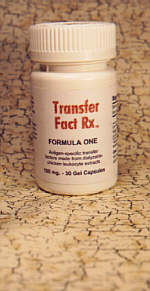
 TM
Does the immune system "know" how to
protect you, or
does it have to be "taught"?
 There are over 2,000,000
antigens --
chemicals of enormous variety, which the body must identify
in order to act against invaders. But how does the body know these
antigens -- "friend from foe"?
Answer: The immune system has to be "taught." There are over 2,000,000
antigens --
chemicals of enormous variety, which the body must identify
in order to act against invaders. But how does the body know these
antigens -- "friend from foe"?
Answer: The immune system has to be "taught."
 This is the story of transfer factors --
and how an amazing medical development that started in 1949
has been derailed by cheap, diluted alternatives ... and
what it will take to maximize the potential of this
promising disease-fighting approach.
This is the story of transfer factors --
and how an amazing medical development that started in 1949
has been derailed by cheap, diluted alternatives ... and
what it will take to maximize the potential of this
promising disease-fighting approach.
 [See our complete Transfer Factor
product listing
[See our complete Transfer Factor
product listing
 Product Comparison
Product Comparison
 Order]
Order]

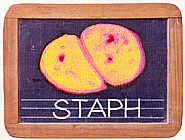
 ne of the great mysteries of advanced
animal physiology has been the ability of the immune system to
respond to so many different threats -- from foreign
cells to pathogenic microbes to toxic agents.
The antigens which the human immune system must recognize
to ward off or neutralize these invaders number in the millions. ne of the great mysteries of advanced
animal physiology has been the ability of the immune system to
respond to so many different threats -- from foreign
cells to pathogenic microbes to toxic agents.
The antigens which the human immune system must recognize
to ward off or neutralize these invaders number in the millions.
 How does the body do it? How does the body do it?
 We know that
even in infancy that the humoral response, involving the production of antibodies,
is well developed. In addition, we know that small
molecular-weight proteins (under 5,000 Daltons) are
found in colostrum, mother's milk in the first few
days of feeding after birth. (Mother's milk not
only provides these important tiny proteins, but it
provides an ample dose of antibodies.) The role of these tiny
proteins, which act together to form a second
immune system of antigen identification and response
called cell-mediated response, has only
been recognized in the scientific community within
the last 50 years. (Various home-grown
immunotherapies have been developed, based on this
principle, using, by way of example,
using cow's colostrum as the carrier of specific antibody-producing
proteins. Moreover, rat studies have already confirmed that
these substances work
across species barriers.) We know that
even in infancy that the humoral response, involving the production of antibodies,
is well developed. In addition, we know that small
molecular-weight proteins (under 5,000 Daltons) are
found in colostrum, mother's milk in the first few
days of feeding after birth. (Mother's milk not
only provides these important tiny proteins, but it
provides an ample dose of antibodies.) The role of these tiny
proteins, which act together to form a second
immune system of antigen identification and response
called cell-mediated response, has only
been recognized in the scientific community within
the last 50 years. (Various home-grown
immunotherapies have been developed, based on this
principle, using, by way of example,
using cow's colostrum as the carrier of specific antibody-producing
proteins. Moreover, rat studies have already confirmed that
these substances work
across species barriers.)

 In 1949 Dr. H.S. Lawrence
used white blood cell extracts (leukocytes and lymptocytes)
to prove that immune response can be transferred from a human
(animal) host who tests positive for exposure to a specific
antigen to a recipient who tests negative -- all via
small weight proteins he called "Transfer Factor" (TF).
It became evidence that immune response had, in fact,
been transferred when subjects receiving antigen-specific
TF became skin-test positive for that antigen, having
previously tested negative. The skin irritation (positive
response) proved that immune response occurred, and
that the immune system had gained knowledge of the
specific antigen. What made this research so ground-breaking
was the discovery that not would was immune response
transferrable, but that the benefit was conveyed
without sending any actual antibodies.
Only the low-weight TF proteins were sent. In 1949 Dr. H.S. Lawrence
used white blood cell extracts (leukocytes and lymptocytes)
to prove that immune response can be transferred from a human
(animal) host who tests positive for exposure to a specific
antigen to a recipient who tests negative -- all via
small weight proteins he called "Transfer Factor" (TF).
It became evidence that immune response had, in fact,
been transferred when subjects receiving antigen-specific
TF became skin-test positive for that antigen, having
previously tested negative. The skin irritation (positive
response) proved that immune response occurred, and
that the immune system had gained knowledge of the
specific antigen. What made this research so ground-breaking
was the discovery that not would was immune response
transferrable, but that the benefit was conveyed
without sending any actual antibodies.
Only the low-weight TF proteins were sent.
Educating Your Immune Cells
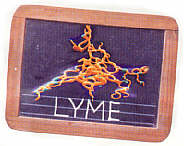
 If antibodies are not transferred,
and TF itself does not directly create antibodies or attack antigens or
their hosts, what is actually being transferrred? How does TF enliven
the body's immune potential?
 What has emerged since the work of
H.S. Lawrence is an understanding of TF's as not mere nutrients.
They are educators -- teaching the cell-mediated immune system
to recognize specific antigens, and with it a knowledge of
when they are present. This is probably why orthodox medicine
is having problems embracing the TF model or approach to
disease. It is a radical departure from the standard
pharmacological models. TF's do not cure anything.
Antigen-specific TF's do not eliminate the condition
or agent behind the antigen they help their host
identify. Instead, they work in an immunosupportive
capacity to make the immune system "smarter," so that
the body is better able to eliminate disease conditions
on its own.
 For years, alternative practitioners
have encouraged patients with immune deficiencies to take commercial-sold
colostrum, which are usually of bovine origin. In light of the function of
transfer factors, we now understand how such colostrum, void as it is
of specific-antigen information, would help some patients. Colostrum,
even from cows, contains lactoferrin and growth factor, along with
other lower-weight proteins that are beneficial to human immune
system function. This is probably why colostrum has been referred
to as "the original transfer factor."
Specific vs. Non-Specific / Standardization
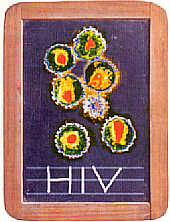
 To understand transfer factors, you
first to understand the difference between non-specific (or general) transfer
factors and those which are specifically designed to address a condition.
This is an important part of educating the consumer, because there is
a great difference in production cost (and therefore subsequent
cost in the wholesale and retail markets). Some companies have profited
handsomely because most consumers do not understand the
difference. (This has incentivized the industry, as a whole,
to be quiet, or to downplay the issue, for monetary gain.
We provide our own Transfer
Factor Comparison Chart so that consumers understand
other important factors that affect the efficacy of the
finished product.) To understand transfer factors, you
first to understand the difference between non-specific (or general) transfer
factors and those which are specifically designed to address a condition.
This is an important part of educating the consumer, because there is
a great difference in production cost (and therefore subsequent
cost in the wholesale and retail markets). Some companies have profited
handsomely because most consumers do not understand the
difference. (This has incentivized the industry, as a whole,
to be quiet, or to downplay the issue, for monetary gain.
We provide our own Transfer
Factor Comparison Chart so that consumers understand
other important factors that affect the efficacy of the
finished product.)
 Another property of TF's that
has helped obscure the picture for consumers and practitioners alike
--- whereas other nutraceutical products employ the
use of one or two compounds, subject to quantitative chemical
analysis, TF's are broad in their range of discrete testable
compounds, making not only chemical standardization difficult,
but content verification. Consumers are left with little more
to go on than the reputation of the supplier in their reliance
on content AND value for their purchase. Another property of TF's that
has helped obscure the picture for consumers and practitioners alike
--- whereas other nutraceutical products employ the
use of one or two compounds, subject to quantitative chemical
analysis, TF's are broad in their range of discrete testable
compounds, making not only chemical standardization difficult,
but content verification. Consumers are left with little more
to go on than the reputation of the supplier in their reliance
on content AND value for their purchase.
 Alpha Omega Labs
sells both categories of product,
as can be seen from our Transfer
Factor product page. One can easily see that the specific-antigen
product costs more. Our Transfer Fact Rx "General Enhance"
is non-specific; whereas "Formula One" through "Formula Nine" are
quite specific. These formulas as made using chickens as hosts,
which are exposed to a certain type of bacteria, virus, or other
antigen-producing agents which are associated with specific
diseases. TF's are then extracted from the white blood cells of
these chickens and made into orally administerable pills.
(The lab which manufacturers these products for us
in the U.S. has specialized in transfer factors for over two
decades and has been a supplier of TF's, animal blood plasmas,
and other blood products to a variety of
research institutions there, including the U.S. Government's
own CDC (Center for Disease Control).) Alpha Omega Labs
sells both categories of product,
as can be seen from our Transfer
Factor product page. One can easily see that the specific-antigen
product costs more. Our Transfer Fact Rx "General Enhance"
is non-specific; whereas "Formula One" through "Formula Nine" are
quite specific. These formulas as made using chickens as hosts,
which are exposed to a certain type of bacteria, virus, or other
antigen-producing agents which are associated with specific
diseases. TF's are then extracted from the white blood cells of
these chickens and made into orally administerable pills.
(The lab which manufacturers these products for us
in the U.S. has specialized in transfer factors for over two
decades and has been a supplier of TF's, animal blood plasmas,
and other blood products to a variety of
research institutions there, including the U.S. Government's
own CDC (Center for Disease Control).)
"Treatment" vs. "Pulse Mode"
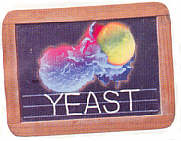
 Researchers in transfer factor
often talk using TF's in immunotherapy modalities versus the infrequent
use of TF's to just "maintain immune health." There is solid research
to support the value of both, given that full immune function relies
on the ability of immune cells to store the "memory" of those two
million plus antigens. While some "loose memory" after three to
five months, others loose this knowledge through repeated cell
replacement so that after so many generations, no cells are left that
"remember" the proper immune response to a specific antigen.
A person who has had previous bouts with a particular illness,
or who may be genetically pre-disposed to a specific disease,
for example, would do well to apply "pulse mode" to a
specific-antigen TF that matches that disease. This usually means
taking the standard dose of that product for one week every three
months. Researchers in transfer factor
often talk using TF's in immunotherapy modalities versus the infrequent
use of TF's to just "maintain immune health." There is solid research
to support the value of both, given that full immune function relies
on the ability of immune cells to store the "memory" of those two
million plus antigens. While some "loose memory" after three to
five months, others loose this knowledge through repeated cell
replacement so that after so many generations, no cells are left that
"remember" the proper immune response to a specific antigen.
A person who has had previous bouts with a particular illness,
or who may be genetically pre-disposed to a specific disease,
for example, would do well to apply "pulse mode" to a
specific-antigen TF that matches that disease. This usually means
taking the standard dose of that product for one week every three
months.
A Growing Body of International Support
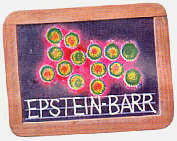
 Far from cowering at the fringes
of therapeutic conjecture and universal orthodox derision, TF's as
a legitimate immunotherapy is gaining wide acceptance.
There are now a variety of medical symposiums held yearly
on transfer factor research, much of it devoted to sharing
TF protocols and clinical successes. Six million Chinese people
use transfer factors to help protect against
heptatis. Even in the U.S., TF as an immunotherapy
is covered by Medicare, and legitimate TF treatments
have also been covered by Blue Cross Blue Shield and several
other insurance carriers for years. Veterinary applications
are also making headway with TF products now used to
treat canine parvovirus, Newcastle's disease in chickens,
coccidioides parasites in cattle, and rheumatism
in horses. Far from cowering at the fringes
of therapeutic conjecture and universal orthodox derision, TF's as
a legitimate immunotherapy is gaining wide acceptance.
There are now a variety of medical symposiums held yearly
on transfer factor research, much of it devoted to sharing
TF protocols and clinical successes. Six million Chinese people
use transfer factors to help protect against
heptatis. Even in the U.S., TF as an immunotherapy
is covered by Medicare, and legitimate TF treatments
have also been covered by Blue Cross Blue Shield and several
other insurance carriers for years. Veterinary applications
are also making headway with TF products now used to
treat canine parvovirus, Newcastle's disease in chickens,
coccidioides parasites in cattle, and rheumatism
in horses.
Links
 Our original Transfer Factor introductory page
when first introduced in 2003.
Our original Transfer Factor introductory page
when first introduced in 2003.
|
 To U.S. Users: To U.S. Users: Neither
Transfer factors, or any of the statements made on this page,
have been evaluated by the U.S. Food & Drug Administration.
The products cited on this page are not
intended to diagnose, treat, cure, mitigate or prevent any disease,
and the information provided on this page is for research
purposes only.
|
Product
Descriptions
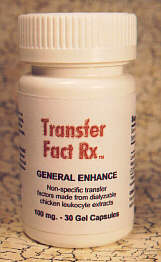
There are twelve different formulas,
all detailed in our Transfer Rx product
page. Brief descriptions are provided below:
General Enhance is our own "non-specific" TF formula.
It contains low molecular weight whey and colostral fractions,
lactoferrin, and alpha lipoic acid to nutritionally support
immune function.
Formula One through Formula Eight are "true"
transfer factor formulas --- antigen-specific and specifically
targeted to particular pathogenic microbes and/or
disease conditions. Again, the specificity of
each formula is given on the
Transfer Rx product
page.
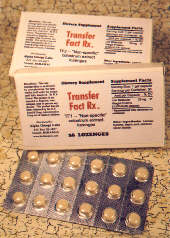
Transfer Fact Rx Lozenges,
like our "General Enhance" formula, is non-specific. You
just place one lozenge per day under the tongue (the
taste is not at all unpleasant) and allow to dissolve.
This makes taking TF easy and is ideal for those
who are observing a "pulsing mode" period where
compliance in frequency may be difficult due to
a busy lifestyle.
Transfer Fact Rx
Elixir is sold by the vial and is accompanied by
an injectable syringe for easy extraction. This product
is not made or represented as being designed for
IM or IV injectible use. The manufacturing of the
product is imply made easier by using vial
dispensing in the form of the finished product.
Sales in the U.S. and Canada will be restricted
to medical doctors and authorized researchers,
for reasons of legal liability. No other
Transfer Fact Rx product will carry
this restriction.
|